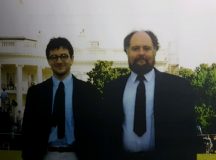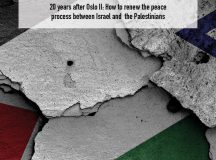Calev Ben-Dor praises The Human Factor as a great piece of documentary making but argues it is ultimately an unreliable account of the reasons for the failure of the peace process.
The Human Factor (now showing on Amazon Prime) is an interesting, aesthetically beautiful, anecdotally fascinating documentary about the Israeli-Arab and Israeli-Palestinian peace process from 1991 to 2000. Yet unfortunately it suppresses one of the major reasons for its collapse, namely the inability of PLO Chairman Yasser Arafat to sign off on an end of conflict agreement.
Combining photography and footage from the time with interviews with six key members of the American negotiation team – Gamal Helal, Martin Indyk, Daniel Kurtzer, Rob Malley, Aaron David Miller and Dennis Ross – the Human Factor presents American perspectives of the process – its highs, lows and frustrations.
Sprinkled within the narrative is a large amount of humour and even some self-deprecation. Miller recounts how Secretary of State James Baker wished to be a Middle East negotiator in his next life because that way he’d ‘be guaranteed a permanent source of employment’. Ross tells a wonderful anecdote of going to meet Arafat in Tunis only to find his armed revolutionaries watching Golden Girls on TV and Arafat requesting to cut Ross’ chicken for him. Indyk describes the ins and outs of the creative attempts to prevent Arafat kissing Rabin (and everyone else he meets). In the end, Edward Djerejian, who is given the crucial job, creates a double handed handshake to block any mouth action. The next day President Clinton is coached on how to do the handshake.
While the US wasn’t involved in the secret Oslo negotiations that led to the September 1993 Declaration of Principles, the Clinton administration happily took ownership over it. Ross tells Secretary of State Warren Christopher that it represented a historic breakthrough: ‘These are two national movements competing for the same space – and here’s a document that has them recognising each other and we should embrace it’. Yet he was also circumspect. It’s aspirational’ Ross says. ‘There is nothing concrete here so the real hard work will begin now … But a historic threshold has been crossed. Because they are taking an existential conflict and turning it into a political conflict.’
As the dust settles from the historic signing in the Rose Garden, it becomes increasingly clear that the devil is in the details and that Palestinians and Israelis have completely different conceptions of what Oslo entails. The constructive ambiguity surrounding the final status issues of refugees, Jerusalem, settlements, security and others lead both sides to create completely different expectations over what a comprehensive final agreement would look like. Kurtzer describes the sides as inhabiting ‘two different universes’ while Indyk argues that the agreement left too much to the implementation process. Helal asks whether a more accurate phrase should be destructive ambiguity.
While starting taciturn, the Arafat-Rabin relationship warmed by September 1995, just two months before the latter’s assassination. In an interesting anecdote, the negotiators are forced to leave one sensitive issue – whether Palestinians can have a police station near Hebron – to a decision by the two leaders. Arafat says generously ‘whatever is acceptable to the Prime Minister’. Rabin responds graciously ‘you will have a police station there’. They shake hands and the issue is settled. When they leave the room, Arafat puts his hand on Rabin’s back. Indyk adds optimistically that ‘they had moved from being adversaries to partners for peace’.
For the Americans, inter-personal relations form a critical component in advancing the process. As Ross says, ‘One can’t ignore the human factor.’ Time and again, American interlocutors portray Arafat as someone for whom respect and dignity is tantamount. When he is initially convinced to wear a suit to the White House signing ceremony, rather than his traditional military fatigues, he changes his mind once his entourage laugh at him in his new clothes. He warms to Rabin after the premier reassures him that the Israelis ‘take him very seriously’. Years later, he feels that both Benjamin Netanyahu and Ehud Barak didn’t show him enough respect or took him for granted.
Rabin’s assassination constitutes a huge blow to the peace process, (although it’s worth remembering that Netanyahu was ahead in the polls at the time, with the majority of the Israeli public having turned against Oslo due to a series of Hamas terror attacks and suicide bombings.) But it’s also personally painful for the American administration. In a particularly moving scene, Ross – who over 25 years on is recounting how he felt when he heard the news – struggles to contain his emotion and complete his sentence. For Clinton it was a ‘transformational event’, in Ross’ words. Clinton now felt a personal responsibility to fulfil Rabin’s legacy, especially as he had told the Israeli Prime Minister that Rabin’s job was to take risks for peace and that his (Clinton’s) job was to minimise those risks. After Rabin is killed, Clinton feels like he owes Rabin a debt. As Ross says, the President ‘had a sense of mission because of this.’
Rabin’s death, followed by the administration’s success in forging an agreement between Arafat and the more sceptical Netanyahu at Wye River in October 1998, gives Clinton a sense of confidence that, in the words of Miller, ‘If you put me in a room with an Israeli and Palestinian leader who are even remotely interested in cutting a deal, I can cut that deal.’ As the Lewinsky scandal and impeachment threaten to topple Clinton, the President further throws himself into the peace process. In December 1998, Clinton visits Gaza to mark the opening of the international airport and to speak at the Palestine National Council. In a speech that Ross recounts made him tear up, Clinton emphasises that ‘we must acknowledge that neither side has a monopoly on pain or virtue’. Amazingly, having had so little time to prepare due to domestic troubles, Clinton ad libbed the entire speech.
Barak is elected in May 1999 and has grand plans for final-status agreements with both Syria and the Palestinians. Ross warns him that doing ‘Syria first’ will make Arafat suspicious and feel like he isn’t being treated with respect, but – as Ross says in his usual diplomatic way – ‘Barak is someone who thought he knew best’. When the Syria talks fail, Barak unilaterally withdraws from Lebanon, in a move that strengthened Hezbollah and the narrative that Israelis only understand force. Miller recounts how he sat with Arafat on the night of the withdrawal and how the Palestinian leader felt Barak was taking him for granted. ‘He felt he was made to look the fool’ says Ross. ‘He’s negotiating and what is he getting? And they [Hezbollah] do violence and they get it all.’
There seems to be deep frustration with Barak amongst the American negotiators, especially the feeling that he convinces Clinton to call a summit at Camp David in July 2000 even though the sides aren’t ready, that he sought to use the president’s credibility to prise compromises out of Arafat. Malley explains that Barak pressurises the President to call a summit while Miller argues that ‘Barak saw himself as Churchill … So he pivots, but he pivots without thinking and he creates a world unto himself.’ Yet Barak – once he thinks Clinton is willing to leave the summit itself – brings far-reaching proposals, especially on Jerusalem. Barak offered to divide the capital and for Arab neighbourhoods as well as the Old City’s Muslim and Christian quarters to come under Palestinian sovereignty. Yet Arafat, who Helal says felt he was dragged to Camp David, doesn’t feel he can accept. Arafat felt he could be killed. (Barak felt the same but seemed to believe that’s what being a leader was about.) As Indyk explains, ‘What we didn’t understand but what’s obvious in retrospect is that this was an End of Conflict deal – there was no chance to revise it later. And the proposal would have left Israel with sovereignty over the Temple Mount/Haram Al Sharif … This is what exactly what Arafat needed to reject the whole thing. Because no Arab leader – as he told us – would accept that sovereignty over the third holiest site in Islam would be in Israel’s hands.’ Miller says Arafat ‘would have had a billion Muslims who would have issued Fatwas for his death had he compromised on any aspect of the Jerusalem issue’.
The negotiators in The Human Factor briefly discuss the Second Intifada, which broke out in September, just three months after the summit failed (Arafat’s role in the violence remains deeply debated but isn’t mentioned). The viewer is then treated to a montage of meetings between Israeli Palestinian and American leaders – Bush, Obama, Trump, Sharon, Olmert, Netanyahu, Abbas and others – against the backdrop of pictures and reports of violence, explosions and tears. We see Obama looking suspiciously at Netanyahu (although not at Abbas – despite the Palestinian leader failing to respond to a far-ranging American framework agreement in 2014 that would have given the Palestinians a capital in East Jerusalem). As Helal tells viewers his doubts about the viability of the two-state solution, Indyk reminds viewers that the process ‘is a history of missed opportunities. Not just the Arabs who missed the opportunities, but Israel and Americans missed opportunities too – and it’s a tragedy’.
There’s also soul searching. Miller is particularly critical of his own (and the administration’s) role, arguing that too often the Americans served as Israel’s lawyer, trying to convince the Palestinians to accept Israeli proposals rather than pushing Israel or serving as an honest broker. He also feels the summit was a bad idea. ‘”Trying and failing is much better than not having tried at all” – that’s a slogan for a college team’ he says. ‘Failure costs. We saw the world how we wanted it to be, we did not see the world the way it was.’ Clinton and Barak, according to Miller, wrongly believed that the ‘power of personality and the power of persuasion and the power of manipulation could somehow transform and change Arafat. They wanted to ascend a mountain by the very power of their own personas … and that’s why both of them hold Arafat in such contempt and fundamentally responsible for not recognising his moment.’
The Debate over the Blame Game
All essays, books and documentaries about the Israeli-Palestinian conflict or peace process will inevitably be criticised for perceived bias. Do they give too much or too little attention to any number of factors: Israeli settlement building, (which wasn’t forbidden under Oslo, but which generated deep Palestinian distrust of Israeli seriousness); Hamas terrorism; the ongoing Israeli occupation; Rabin’s assassination; Barak’s persona?
The main Israeli narrative – primarily formed by Barak and his ‘we don’t have a partner’ speech after Camp David and the Intifada, completely blamed Arafat for the collapse of the talks. Israeli (left wing) negotiators were also highly critical of the Palestinian leader. Foreign Minister Shlomo Ben-Ami charged Arafat as being unprepared to give up Palestinian mythology (he also described negotiating with him as like trying to pick up mercury with a fork.) Gilead Sher, the Prime Minister’s Chief of Staff, saw him as a leader of a national movement rather than a statesman.
By August 2001 – following an exchange in the New York Review of Books, two competing narratives over the process’ failure during the Clinton Administration began to consolidate. One narrative promoted by long time PLO adviser Hussein Agha and Rob Malley argued that the failure was a ‘tragedy of errors’. At Camp David, they write, Arafat was ‘persuaded that the Israelis were setting a trap. His primary objective thus became to cut his losses rather than maximize his gains.’ That does not mean, say Agha and Malley, that ‘he ruled out reaching a final deal; but that goal seemed far less attainable than others.’ Ultimately, there were a number of components that led to failure: ‘years of accumulated mistrust and loss of faith in the peace process, political circumstances in Israel and among the Palestinians, the history of prior agreements, perceptions of the United States’ role, the relationship (or lack thereof) between Barak and Arafat, the mechanics of the negotiations – all these contributed to a situation in which each side’s actions were interpreted by the other in the most damaging way.’
The other narrative, led by Dennis Ross, believed that Arafat was inherently incapable of doing a permanent status deal, ‘never ready – mentally, personally, or historically – to conclude a deal with Israel. In his magnum opus, The Missing Peace, Ross argues that ‘Arafat was not going to say yes under any circumstances … Arafat was seeking to have it both ways, creating the illusion of being positive by accepting the ideas but practically rejecting them with his reservations. We were seeing a variant of what Arab leaders had always referred to as ‘the Arafat answer’: La-Na’am (no and yes in Arabic).’ Ross determines that the Palestinian leader ‘could not do a deal that ended the conflict. Partial deals were possible because they did not require him to adopt any irrevocable positions. But a comprehensive deal was not possible with Arafat. Too much redefinition was required. He was not up to it. He could live with the process, but not with a conclusion.’
The Arafat enigma
What did Arafat ultimately want? It’s impossible to know. If the real Churchill were to anachronistically be asked about the Palestinian leader, he might have described him as a riddle wrapped in a mystery, inside an enigma. Agha once joked to Shlomo Ben Ami that it takes a Talmudic scholar to analyse the behaviour of Arafat and to fully understand him. For Agha, as he explained in a recent Decision Points podcast with David Makovsky, Arafat wasn’t some deep thinker who misled the world, negotiating on the one hand while planning violence on the other. ‘When people ask me what’s Arafat’s strategy, I tell them that’s an oxymoron. There’s no such thing as Arafat’s strategy, there’s no such thing as Arafat’s plan. You live day by day and you try and accumulate as many assets as you can to improve the lot of your people – and that’s it – and that’s not a strategy.’
Indeed, the fact that two of the six interviewers featured in the Human Factor voiced these different perspectives makes for great viewing. But Ross’ serious critique of Arafat seems is difficult to find in the documentary especially when compared to the emphasis on Barak and the tactical errors that each side made.
Of course, it is completely legitimate to prefer one explanation over the other. To paraphrase Clinton in his ad libbed Gaza speech, ‘we must acknowledge that neither side has a monopoly on virtuous narratives.’ Yet what is less legitimate – I’d argue inexplicable – is that numerous events and evidence that would strengthen Ross’ claims of Arafat’s as a deeply problematic interlocutor are simply omitted from the documentary.
For example, the documentary discusses the May 1994 Gaza-Jericho Agreement, but not the part where Arafat – at the last moment – refuses to sign the map (before being shouted at by Egyptian President Mubarak who allegedly threatens ‘sign it, you dog!’). Indyk and Miller are at pains to explain how signing an agreement without Palestinian sovereignty over the Temple Mount is a no-go for Arafat at Camp David, yet there is no mention of Arafat’s rejection of the historical fact that the Jewish Temple(s) in Jerusalem ever existed.
The biggest omission relates to the final part of the Clinton administration’s attempt to bring about a comprehensive agreement. Why on earth – after describing the conferences and / or agreements in Madrid, Oslo, Gaza-Jericho, Wye River, Shepherdstown and Camp David (and subsequently showing pictures from Annapolis and numerous other negotiations between the sides over an additional two decades) – would the documentary omit the final status parameters that are presented to both sides in late December 2000, just before Clinton leaves office, which Arafat fails to respond positively to?
Those parameters went further than the Israeli offer at Camp David, which we are told were difficult for Arafat to accept. They offered an independent Palestinian state on approximately 97 per cent of the West Bank and – particularly significant – Palestinian sovereignty over the Temple Mount. And whereas at Camp David in July Arafat allegedly couldn’t agree because he needed the agreement of the Muslim world, in December, the administration secured support from President Mubarak of Egypt, Crown Prince Abdullah of Saudi Arabia, King Abdullah of Jordan, President Ben Ali of Tunisia and King Mohammad of Morocco and others. Mubarak told Clinton his ideas were historic, and he would encourage Arafat to accept them. Saudi and Egyptian Ambassadors pushed hard on Arafat to accept. Then Saudi Ambassador Prince Bandar relates that when he realised Arafat wasn’t able to respond positively he ‘wanted to cry’ and his ‘heart was burning at how the opportunity was lost again’.
Indyk also published a memoir about this period, the 2014 Innocent Abroad: An Intimate Account of American Peace Diplomacy in the Middle East. In views that echo what we hear in the Human Factor, Indyk writes that ‘The truth is that the Camp David summit failed because Arafat rejected Clinton’s offer on Jerusalem…which fell short of his minimum requirements on Palestinian sovereignty over the Haram al-Sharif’. Yet in an opinion we pointedly do not hear in the documentary, Indyk points out that ‘the final status negotiations did not end at Camp David…but actually marked the beginning of intensive negotiations that continued through January 2001. During that period many of Arafat’s concerns that were left unaddressed at Camp David were dealt with in detail, in particular…Palestinian sovereignty over the Haram al Sharif. If that is what he had been holding out for at Camp David’ Indyk asks ‘why did he turn down the Clinton offer?’
In other words, between July to December the Americans moved towards the Palestinian position on the Temple Mount. They lined up near wall-to-wall Arab support. Yet Arafat found new points to query – the American proposal of refugees, or Israeli sovereignty over the Western Wall. In his memoirs, Clinton writes about his deep frustration with the Palestinian leader. In their final conversation, Arafat tells Clinton he is a great man, and Clinton responds that he isn’t, he is a failure ‘and you made me one’.
For Ross (in his book and pointedly not in the Human Factor) the two sides came close; ‘Were the Palestinian negotiators ready to do the deal that was available? Yes. Did we ultimately fail because of mistakes that Barak made and the mistakes that Clinton made? No, each regardless of tactical mistakes, was ready to confront history and mythology. Only one leader was unable or unwilling to confront history and mythology. Yasser Arafat.’ Indyk answers his own question (again in the book rather than in the documentary) ‘Rather than breaking through into a new world, he [Arafat] clung to what he knew best – the ways of the old Arab order.’
One can agree or disagree with Ross, Indyk, Malley or the other experts. One can think that Barak or Arafat – or a host of other factors – were at fault for failure. But if a documentary seeks to provide a comprehensive view of American perspectives on peacemaking, it seems strange at best and dishonest at worst to exclude the last and most groundbreaking attempt by the administration to bring peace, as well as seemingly omitting the deep criticisms at least some of these negotiators had of one of the leaders.































